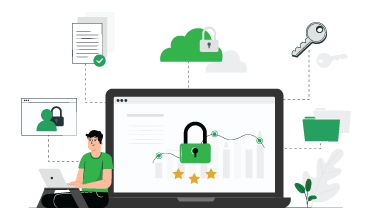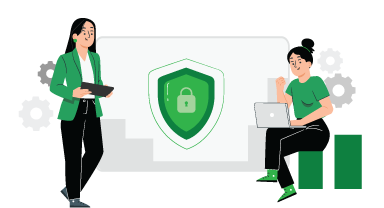
Cybersecurity standards and frameworks are critical tools for helping organizations protect their systems, networks, and data from cyber threats and vulnerabilities. These standards and frameworks provide a set of guidelines, best practices, and requirements that organizations can follow to ensure the security and integrity of their information and systems.
There are many different cybersecurity standards and frameworks that have been developed by industry organizations, government agencies, and other stakeholders. These standards and frameworks are designed to address a wide range of issues, including data protection, network security, incident response, and risk management.
One of the most widely recognized cybersecurity standards is ISO/IEC 27001, which outlines the requirements for an organization’s information security management system (ISMS). This standard provides a framework for establishing, implementing, maintaining, and continually improving the security of an organization’s information.
By adopting and consistently following industry-recognized cybersecurity standards and frameworks, organizations can significantly reduce their risk of data breaches and cyber attacks and ensure the protection of sensitive information and the integrity of their systems and networks.
Standards and frameworks are popular in cybersecurity for a number of reasons. One of the main benefits of standards and frameworks is consistency. These guidelines provide a common set of best practices that organizations can follow, which helps to ensure that they are approaching cybersecurity in a consistent and effective way. This is particularly important for organizations that operate in regulated industries or handle sensitive information, as failure to follow appropriate cybersecurity measures can have serious consequences.
Another reason that standards and frameworks are popular in cybersecurity is that they can help organizations effectively manage their risks. These guidelines provide a framework for identifying and prioritizing cybersecurity risks and implementing appropriate controls to mitigate those risks. This is especially important in today’s rapidly changing threat landscape, where new vulnerabilities and threats are constantly emerging.
Standards and frameworks are also popular in cybersecurity because they can help organizations comply with regulatory requirements. Many organizations are required to follow certain cybersecurity standards and frameworks in order to meet regulatory requirements or to maintain certain certifications. For example, organizations that handle credit card information must comply with the Payment Card Industry Data Security Standard (PCI DSS).
Another reason that standards and frameworks are popular in cybersecurity is that they are based on established best practices. These guidelines are often developed by industry experts and are designed to help organizations effectively protect their systems and data. By following these standards and frameworks, organizations can ensure that they are taking appropriate measures to protect their systems and data.
Finally, standards and frameworks are popular in cybersecurity because they can significantly improve an organization’s overall security posture and reduce its risk of data breaches and cyber attacks. This is especially important for organizations that handle sensitive or critical information, as a data breach or cyber attack can have serious consequences. Adopting and consistently following industry-recognized cybersecurity standards and frameworks can help organizations effectively defend against threats and protect their systems and data.
Several factors contribute to the reliability and trustworthiness of a cybersecurity standard or framework. The first one is the credibility of the organization or entity that developed the standard or framework. Standards and frameworks that are developed by respected industry organizations or government agencies are generally considered more reliable and trustworthy than those developed by less well-known entities.
Another factor is the level of stakeholder involvement in its development. Standards and frameworks that are developed through a transparent and inclusive process, with input from a wide range of stakeholders, are generally considered more reliable and trustworthy than those developed by a small group of individuals.
The level of adoption and implementation of a standard or framework is also an important factor. Standards and frameworks that are widely adopted and implemented by organizations are generally considered more reliable and trustworthy than those that are not widely used.
There are many well-known and recognized cybersecurity standards and frameworks, including:
- ISO/IEC 27001 (link): This is an international standard that outlines the requirements for an organization’s information security management system (ISMS). It provides a framework for establishing, implementing, maintaining, and continually improving the security of an organization’s information.
- NIST Cybersecurity Framework (CSF) (link): This is a set of guidelines and best practices for managing cybersecurity risk. It provides a common language and structure for organizations to identify, assess, and prioritize their cybersecurity risks and to implement appropriate controls to mitigate those risks.
- PCI DSS (Payment Card Industry Data Security Standard) (link): This is a set of security standards designed to ensure that all companies that accept, process, store, or transmit credit card information maintain a secure environment. It provides a framework for protecting cardholder data and reducing the risk of data breaches.
- COBIT (Control Objectives for Information and related Technology) (link): This is a framework for the governance and management of enterprise information and technology. It provides guidance on how to align information and technology with the goals of the organization and manage the risks associated with it.
- HIPAA (Health Insurance Portability and Accountability Act) (link): This is a US law that establishes national standards for the protection of sensitive patient health information. It provides a framework for safeguarding the confidentiality, integrity, and availability of this information.
- GDPR (General Data Protection Regulation) (link): This is a regulation in EU law on data protection and privacy for all individuals within the European Union (EU) and the European Economic Area (EEA). It provides a framework for protecting the personal data of individuals and establishing their rights with regard to the processing of that data.
- OWASP Top Ten (link): This is a list of the top ten most critical web application security risks, as identified by the Open Web Application Security Project (OWASP). It provides a framework for identifying and addressing the most common and severe vulnerabilities in web applications.
Matching a cybersecurity standard or framework can be an important aspect of an organization’s overall cybersecurity strategy, but it is not the only aspect. While meeting the requirements of a cybersecurity standard or framework can help an organization protect its systems, networks, and data from cyber threats and vulnerabilities, it is important to note that these standards and frameworks are not a complete solution for cybersecurity.
In addition to meeting the requirements of a cybersecurity standard or framework, organizations should also have other measures in place to protect their systems and data. This may include implementing technical controls such as firewalls and intrusion detection systems, as well as implementing policies and procedures for managing access to information and responding to cybersecurity incidents.
While meeting the requirements of a cybersecurity standard or framework is an important part of an organization’s overall cybersecurity strategy, it is also important to recognize that this is only one aspect of cybersecurity. Organizations should have a holistic approach to cybersecurity that includes a range of measures to protect their systems and data from threats and vulnerabilities.
In terms of terminology, “Cybersecurity” refers to the practices and measures that organizations take to protect their systems, networks, and data from cyber threats and vulnerabilities. “Cyber compliance” refers to an organization’s adherence to the requirements of cybersecurity standards and regulations. So, an organization’s strategy of matching a standard without going further could be considered a form of cyber compliance, but it would not be considered a comprehensive cybersecurity strategy.
There are many different cybersecurity standards and frameworks available, and choosing the right one for your organization can be a challenging task. Here are some factors to consider when deciding which standard to go with:
- Organization size
- Industrial sector
- Regulatory requirements
- Business needs
- Cybersecurity maturity
Ultimately, the right standard or framework for your organization will depend on a variety of factors, including your organization’s size, industry, regulatory requirements, business needs, and level of adoption. It is important to carefully evaluate your options and choose a standard or framework that is the best fit for your organization.
#1 - Standards & Frameworks by Organization Size
The size of your organization can be an important factor in determining which standard to go with. Smaller organizations may find it more practical to adopt a standard that is specifically designed for small businesses, while larger organizations may need to adopt a more comprehensive standard that is better suited to their size and complexity.
Here is a breakdown of some of the most suitable standards and frameworks for organizations of different sizes:
1.1 – Small organizations (1-50 employees)
- OWASP Top Ten
- SANS Top 20 Critical Security Controls (link): This is a list of the top 20 most critical security controls that organizations should implement in order to protect their systems and data. It provides a framework for identifying and addressing the most critical cybersecurity risks.
1.2 – Medium-sized organizations (50-500 employees):
- ISO/IEC 27001
- NIST Cybersecurity Framework (CSF)
- SANS Top 20 Critical Security Controls
1.3 – Large organizations (500+ employees)
- ISO/IEC 27001
- NIST Cybersecurity Framework (CSF)
- COBIT
#2 - Standards & Frameworks by Industrial Segment
The industrial sector in which your organization operates can also be an important factor in determining which standard to go with. Some standards and frameworks are specifically designed for organizations in certain sectors, such as healthcare, finance, or retail. Choosing a standard that is tailored to your industry can help ensure that it is relevant and applicable to your organization.
Here is a breakdown of some of the most suitable standards and frameworks for organizations in different industrial sectors:
2.1 – Healthcare:
- HIPAA
- ISO/IEC 27001
- NIST Cybersecurity Framework (CSF)
2.2 – Finance
- PCI-DSS
- ISO/IEC 27001
- NIST Cybersecurity Framework (CSF)
2.3 – Retail
- PCI DSS
- ISO/IEC 27001
- NIST Cybersecurity Framework (CSF)
2.4 – Government:
- NIST Cybersecurity Framework (CSF)
- FISMA (Federal Information Security Modernization Act) (link): This is a US law that requires federal agencies to develop, document, and implement an information security program to protect their information and information systems. It provides a framework for managing cybersecurity risks in the federal government.
#3 - Standards & Frameworks by Regulatory Requirements
Depending on the industry in which your organization operates, you may be required to comply with certain cybersecurity standards and regulations. For example, organizations that handle credit card information must comply with the Payment Card Industry Data Security Standard (PCI DSS). It is important to consider any regulatory requirements when choosing a standard or framework.
It is not possible to provide a comprehensive list of the ten most suitable standards and frameworks for each type of regulatory requirement, as the specific standards and frameworks that are required or recommended for an organization will depend on a variety of factors, including the nature of the organization’s business, the industry in which it operates, and the specific regulatory requirements that apply.
However, here are some examples of standards and frameworks that may be suitable for organizations that are required to meet certain regulatory requirements:
- Credit card information: PCI DSS
- Personal health information: HIPAA
- EU Citizens personal data processing: GDPR
- Publicly traded companies in the US: SOX (link)
- US Federal Agencies: FISMA
Please note that these are just a few examples of regulatory requirements that may require organizations to adopt specific standards or frameworks. There are many other regulatory requirements and corresponding standards and frameworks that may apply to different organizations. It is important for organizations to carefully evaluate their regulatory requirements and choose standards and frameworks that are appropriate for their specific needs.
#4 - Standards & Frameworks by Business Needs
The specific needs of your organization should also be taken into account when choosing a standard or framework. Consider your organization’s goals, priorities, and risk profile when deciding which standard is the best fit.
Here is a breakdown of some of the most suitable standards and frameworks for organizations based on their business needs:
4.1 – Risk management
- ISO/IEC 27005 (link): This is an international standard that provides guidance on risk management for information security. It provides a framework for identifying, analyzing, and managing information security risks.
- NIST Cybersecurity Framework (CSF)
4.2 – Compliance
- ISO/IEC 27001
- PCI DSS
4.3 – Cybersecurity incident response:
- NIST Cybersecurity Framework (CSF)
- ISO/IEC 27035 (link): This is an international standard that provides guidance on incident management for information security. It provides a framework for identifying, analyzing, and responding to information security incidents.
4.4 – Data protection
- ISO/IEC 27001
- GDPR
4.5 – Cybersecurity training
- ISO/IEC AWI TR 27109 (link): This is an international standard that provides guidance on cybersecurity training, awareness, and competence. It provides a framework for developing and delivering cybersecurity training programs to ensure that employees are aware of and understand their roles and responsibilities in protecting the organization’s information and systems.
- SANS Institute: The SANS Institute is a well-known provider of cybersecurity training and certification programs. It offers a variety of courses and certification programs that can help organizations develop their employees’ cybersecurity skills and knowledge.
#5 - Standards & Frameworks by Cybersecurity Maturity
An organization’s cybersecurity maturity is a measure of its ability to effectively manage and mitigate cybersecurity risks. As an organization matures in its approach to cybersecurity, it may find that it needs to adopt more advanced and comprehensive standards and frameworks in order to effectively protect its systems and data.
Here is a breakdown of some of the most suitable standards and frameworks for organizations based on their cybersecurity maturity:
4.1 – Low cybersecurity maturity
- ISO/IEC 27001
- NIST Cybersecurity Framework (CSF)
4.2 – Medium cybersecurity maturity
- ISO/IEC 27001
- NIST Cybersecurity Framework (CSF)
- COBIT
4.3 – High cybersecurity maturity
- COBIT
- ISO/IEC 27005
- NIST Cybersecurity Framework (CSF)
Standards and frameworks are an important tool for organizations to manage and mitigate cybersecurity risks. They provide a common language and structure for identifying and addressing potential vulnerabilities and threats, and can help organizations ensure that their systems and data are protected against cyber attacks.
There are many different standards and frameworks available, and the right one for an organization will depend on a variety of factors, including its size, industry, and business needs. For example, a small organization with a basic cybersecurity posture may choose to adopt a standard like ISO/IEC 27001, which provides a framework for establishing and maintaining an information security management system (ISMS). A larger organization with a more advanced cybersecurity posture may choose to adopt a more comprehensive framework like the NIST Cybersecurity Framework (CSF), which provides a more detailed set of guidelines and best practices for managing cybersecurity risk.
In addition to size and industry, regulatory requirements can also play a role in determining which standards and frameworks are most suitable for an organization. For example, healthcare organizations may be required to comply with HIPAA, which establishes national standards for the protection of sensitive patient health information. Finance organizations may be required to comply with PCI DSS, which is a set of security standards designed to ensure that all companies that accept, process, store, or transmit credit card information maintain a secure environment.
Ultimately, the decision of which standard or framework to adopt will depend on an organization’s specific needs and goals, as well as its cybersecurity maturity. As an organization matures in its approach to cybersecurity, it may find that it needs to adopt more advanced and comprehensive standards and frameworks in order to effectively protect its systems and data.






